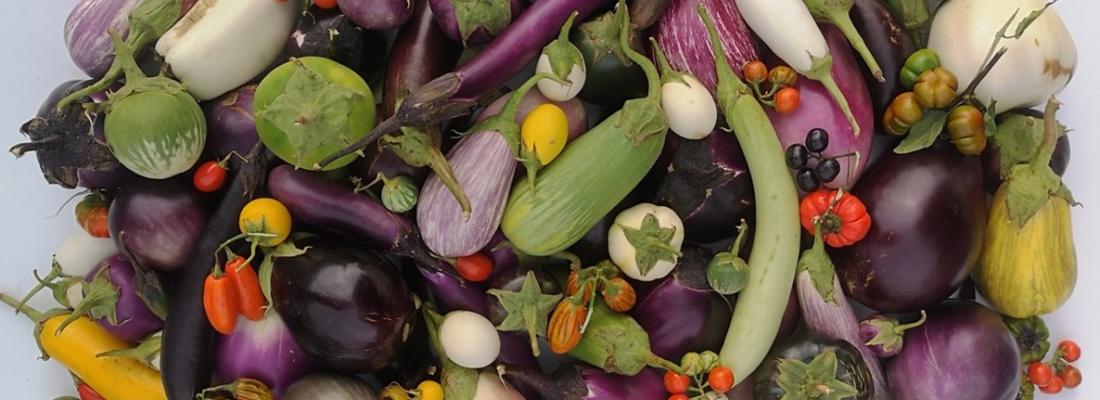Biodiversity Reading time 2 min
An international team uncovers the comprehensive repertoire of genes and agricultural traits of eggplant
PRESS RELEASE - An international research collaboration, including INRAE, has published the complete set of genes (pangenome) and agronomic traits (panphenome) of the eggplant. Beyond the genome, this comprehensive collection encompasses all known genetic variations within the species, including those involved in traits such as prickle development. Drawing on a global collection of more than 3,400 cultivated and wild eggplant varieties, the researchers identified over 20,000 gene families and 218 agronomic traits, including resistance to fungal wilt and antioxidant capacity. The dataset is freely accessible and provides valuable resources for breeders seeking to develop customised varieties adapted to local conditions and ongoing climate change. The results have been published in Nature Communications.
Published on 12 November 2025

Within a species, each individual possesses a unique set of genes that determine its specific traits. In humans, for instance, numerous genetic variations are responsible for differences in eye and hair colour. A pangenome represents the complete repertoire of genes within a species, including all possible variations among individuals. In crops such as eggplant, these variations are the result of thousands of years of human selection. For more than eight years, researchers investigated a global collection of more than 3,400 cultivated eggplant varieties and their wild relatives. This collection included both modern and ancient cultivated varieties, landraces, and wild species. Nearly 700 of these varieties came from the INRAE's Vegetable Biological Resource Centre in Avignon. This vast collection enabled them to trace the history of the domestication and migration of eggplant around the world (see below). The team then conducted field studies to identify the genes responsible for key agronomic traits among the different varieties.
Field studies to characterise the genes and agronomic traits of eggplant
The research team examined 368 eggplant varieties—representative of the global diversity of this species—along with two of its wild ancestors: Solanum insanum and Solanum incanum. The researchers sequenced the genome of each of these varieties and studied 218 agronomic traits in the field, including resistance to drought and diseases, and the composition of the fruit. The field trials were conducted in Valencia (Spain), Montanaso Lombardo (Italy) and Antalya (Türkiye), three locations with different climatic conditions and specific cultivation practices. Using cutting-edge bioinformatic analyses, the researchers were able to determine that the eggplant genome contains 16,300 ‘essential’ gene families—found in all varieties— and 4,000 ‘optional’ gene families—present only in certain varieties. Furthermore, certain traits were observed across all field trials, while others only appeared in specific areas, suggesting that some traits are strongly influenced by the environment.
The study revealed over 3,000 associations between agronomic traits and genes, and, in most cases, identified the DNA mutations responsible for these traits. In this publication, the team focused on three key traits and their associated genes:
- Resistance to Fusarium wilt — a serious fungal disease that affects eggplant productivity
- Isochlorogenic acid content — antioxidant compounds that provide health benefits but are also linked to bitterness and browning of the fruit flesh
- Prickle formation
The remaining 215 traits will be published in future publications.
With global eggplant production reaching nearly 60 million tonnes per year, the publication of the complete collection of genes and agronomic traits for this crop represents a major step forward, enabling a deeper understanding of its history while also helping breeders prepare for future challenges. These publicly available data will enable them to produce tailor-made eggplant varieties adapted to local environmental and climatic constraints, as well as to specific farming practices and consumption habits. These findings further emphasise the importance of preserving genetic biodiversity and highlight the crucial role of Biological Resource Centres in advancing plant genetics research and shaping the agriculture of tomorrow.
Tracing the history of the eggplant
By studying this global collection, researchers were able to trace the history of eggplant domestication, which began in India and Southeast Asia before spreading to the Middle East, Europe, and the Far East (China and Japan), likely via Arab and Chinese trade routes. The researchers were able to study characteristics shaped by human selection as well as those resulting from environmental constraints in the major eggplant-producing regions. For example, varieties originating from India and Southeast Asia have retained the non-purple skin colour and the prickly leaves typical of their wild ancestors, while these traits have gradually disappeared in varieties originating from other parts of the world.
Reference
Gaccione L. et al. (2025). Graph-based pangenomes and pan-phenome provide a cornerstone for eggplant biology and breeding. Nature communications, DOI: https://doi.org/10.1038/s41467-025-64866-1
Study carried out as part of the European projects G2P-SOL and PRO-GRACE
Biological Resource Centres (BRCs) study, collect, characterise and conserve the biological and genetic diversity of domestic animal species, model or cultivated plants, related wild species, microorganisms of agronomic or agri-food interest, and microorganisms and organisms found in the environment. INRAE manages or co-manages 28 BRCs, including the Vegetable BRC in Avignon, which oversees the management and development of collections of five vegetable species: eggplant, pepper (including chilli and bell pepper), tomato, melon and lettuce. The eggplant collection includes nearly 2,000 varieties, landraces, as well as wild accessions. Non-commercial varieties are available to the public upon request in exchange for a financial contribution.
